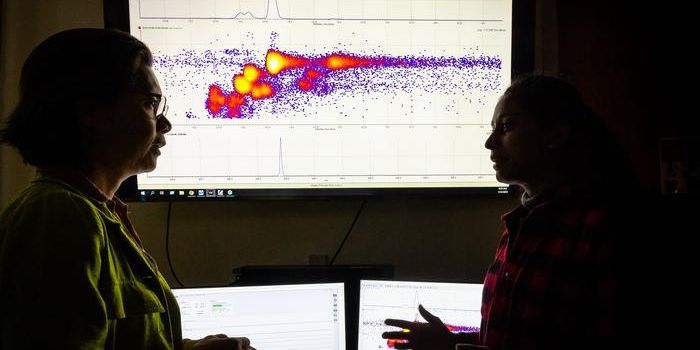Scientists have found traces of life in mantle rocks in core samples taken from the seabed near the famous Lost City hydrothermal field.
Gretchen Bernasconi-Green, a professor at ETH Zurich and co-leader of the
IODP (International Ocean Discovery Program) expedition to the Atlantis Massif in the Atlantic Ocean, recently discussed the findings with university writer Peter Rüegg.
The discovery sounds like a scientific sensation. Is it?
First, I should say that we did not find the signs of life in the earth’s mantle itself, but rather in rock that originates from the earth’s mantle. This rock is found on the seabed at the Atlantis Massif near Lost City. Here the tectonic plates are drifting apart and large active faults have formed that carry mantle material towards the surface, just like a conveyor belt.
We were able to obtain samples of the mantle rock through boreholes, and a microbiologist on the research ship managed to isolate cells from a few of these samples.
What kinds of cells?
For now, all we know for sure is that they are microbial cells. Whether these are bacteria or archaea, it’s too soon to say. What we do know is that they differ considerably from cells found in ocean sediment.
The next step is for the cells to be examined more closely in the laboratory. What’s unusual, and quite exciting for us, is that these cells are present in mantle rock and most likely do not originate from the seawater.
Do you think it’s really possible for life to occur in rock?
Yes, I think it is quite possible. Mantle rock contains a mineral called olivine, which turns into serpentine when it comes into contact with water at low temperatures. This produces hydrogen and methane. Both these gases provide a source of energy for microorganisms that have to manage without sunlight.
Perhaps the cells we found are capable of using these gases, which are present inside the rock, to carry out their metabolic processes. But life in the rock is tough and the microbes are exposed to some very hostile conditions. The fluids that seep out of the vents at Lost City are extremely alkaline—they have a pH value of 11. Thus, both the vents and their environment are difficult to colonize, even for very resistant microorganisms.
What is the significance of finding cells in rock like this?
The conversion of olivine to serpentine may occur on other planets too—on Mars, for example, where the presence of methane and hydrogen has already been established. Some scientists believe that would be sufficient in itself to allow the emergence of basic life forms.
What other goals did you set for the expedition?
Mainly, we wanted to find out how mantle rock ended up on the sea floor and how it reacts with seawater; the primary focus was on the serpentinization process. We also wanted to find out more about the carbonization process that led to the formation of the vents at Lost City.
The chimneys are made of calcium, or rather calcium carbonate, which precipitates from the alkaline fluids. This is a natural form of carbon dioxide fixation.
We wanted to better understand how much carbon is stored as carbonate in these rocks and the potential of this sequestration, especially in terms of an artificial CO2 sequestration on the sea floor or on land, aided by the serpentinization reaction that led to the formation of alkaline hydrothermal vents.
Have you come to any conclusions about this potential yet?
We have not finished analyzing the core samples yet, but I see the potential as being quite limited. It may be feasible, but the effort required to fix significant quantities of CO2 in places like the mid-ocean ridges would be very great—too great for it to be successful.
What other findings resulted from the expedition?
This expedition was the first time that we used a new kind of drill, a seabed rock drill, to extract core samples. These drills sit right on the seabed and can drill 50 to 70 meters into the rock. The advantage over the conventional method is that the drill is not as disturbed by heavy seas.
The drill heads are finer, too, which is less damaging to the rock. As the boreholes are often left open for long periods, thus letting in seawater, we used a new technique to seal up four of the boreholes. This is another example of innovation in sea drilling.
In a year’s time, the area in and around the boreholes will have recovered from the disturbance of drilling and we will be able to remove the plug and take measurements and water samples. We also equipped the drills with a number of different sensors, which, for the first time, were able to measure the water temperature, oxygen reduction potential, methane concentration, and the pH of the water before, during, and after the drilling process.
So what happens next?
The core samples were taken to the Center for Marine Environmental Sciences (MARUM) in Bremen, and over the last two weeks have been examined by the team of 30 participating scientists. Incidentally, women are in the majority on that team—another first on an IODP mission!
They will each take small samples and continue their analysis. The microbiologists will also conduct detailed genetic investigations and make incubation experiments. In about two years, we will reconvene to discuss the results.
Source:
ETH Zurich
This article was originally posted on
futurity.org.









